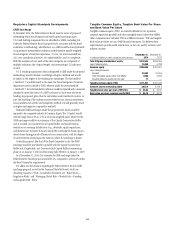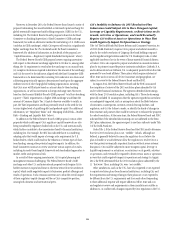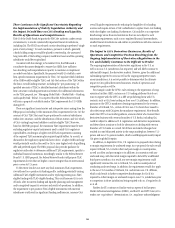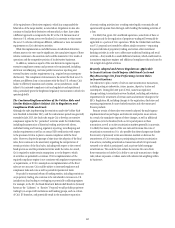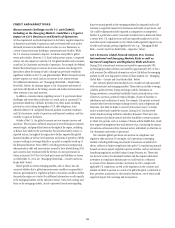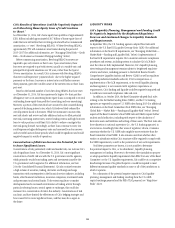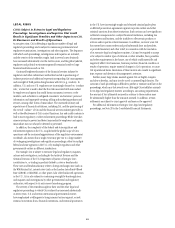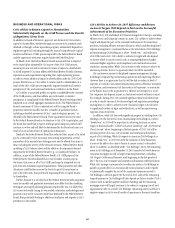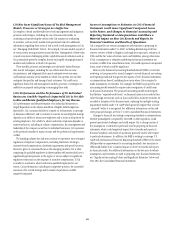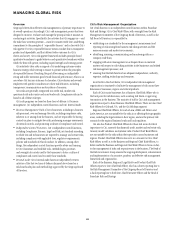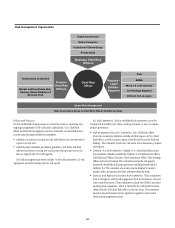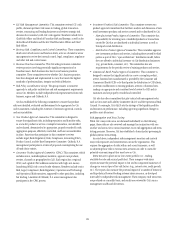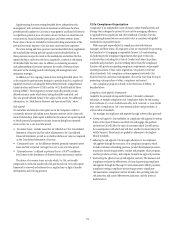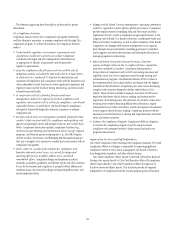Citibank 2014 Annual Report Download - page 79
Download and view the complete annual report
Please find page 79 of the 2014 Citibank annual report below. You can navigate through the pages in the report by either clicking on the pages listed below, or by using the keyword search tool below to find specific information within the annual report.62
BUSINESS AND OPERATIONAL RISKS
Citi’s Ability to Return Capital to Shareholders
Substantially Depends on the CCAR Process and the Results
of Regulatory Stress Tests.
In addition to Board of Directors’ approval, any decision by Citi to return
capital to shareholders, whether through an increase in its common stock
dividend or through a share repurchase program, substantially depends on
regulatory approval, including through the annual Comprehensive Capital
Analysis and Review (CCAR) process required by the Federal Reserve Board
and the supervisory stress tests required under the Dodd-Frank Act.
In March 2014, the Federal Reserve Board announced that it objected
to the capital plan submitted by Citi as part of the 2014 CCAR process,
meaning Citi was not able to increase its return of capital to shareholders
as it had requested. Citi must address the Federal Reserve Board’s concerns,
expectations and requirements regarding Citi’s capital planning process
in order to return additional capital to shareholders under the 2015 CCAR
process. Restrictions on Citi’s ability to return capital to shareholders as a
result of the 2014 CCAR process negatively impacted market and investor
perceptions of Citi, and continued restrictions could do so in the future.
Citi’s ability to accurately predict or explain to stakeholders the outcome
of the CCAR process, and thus address any such market or investor
perceptions, is complicated by the Federal Reserve Board’s evolving criteria
employed in its overall aggregate assessment of Citi. The Federal Reserve
Board’s assessment of Citi is conducted not only by using the Board’s
proprietary stress test models, but also a number of qualitative factors,
including a detailed assessment of Citi’s “capital adequacy process,” as
defined by the Federal Reserve Board. These qualitative factors were cited
by the Federal Reserve Board in its objection to Citi’s 2014 capital plan, and
the Board has stated that it expects leading capital adequacy practices will
continue to evolve and will likely be determined by the Board each year as a
result of its cross-firm review of capital plan submissions.
Similarly, the Federal Reserve Board has indicated that, as part of its stated
goal to continually evolve its annual stress testing requirements, several
parameters of the annual stress testing process may be altered from time to
time, including the severity of the stress test scenario, Federal Reserve Board
modeling of Citi’s balance sheet and the addition of components deemed
important by the Federal Reserve Board (e.g., a counterparty failure). In
addition, as part of the Federal Reserve Board’s U.S. GSIB proposal, the
Federal Reserve Board indicated that it may consider, at some point in
the future, that some or all of Citi’s GSIB surcharge be integrated into its
post-stress test minimum capital requirements. These parameter and other
alterations could further increase the level of capital Citi must meet as
part of the stress tests, thus potentially impacting levels of capital returns
to shareholders.
Further, because it is not clear how the Federal Reserve Board’s proprietary
stress test models and qualitative assessment may differ from the modeling
techniques and capital planning practices employed by Citi, it is likely that
Citi’s stress test results (using its own models, estimation methodologies and
processes) may not be consistent with those disclosed by the Federal Reserve
Board, thus potentially leading to additional confusion and impacts to Citi’s
perception in the market.
Citi’s Ability to Achieve Its 2015 Efficiency and Return
on Assets Targets Will Depend in Part on the Successful
Achievement of Its Execution Priorities.
In March 2013, Citi established 2015 financial targets for Citicorp’s operating
efficiency ratio and Citigroup’s return on assets. Citi’s ability to achieve these
targets will depend in part on the successful achievement of its execution
priorities, including efficient resource allocation, which includes disciplined
expense management; a continued focus on the wind-down of Citi Holdings
and maintaining Citi Holdings at or above “break even”; and utilization
of its DTAs (see below). Citi’s ability to achieve its targets will also depend
on factors which it cannot control, such as ongoing regulatory changes,
continued higher regulatory and compliance costs and macroeconomic
conditions, among others. While Citi continues to take actions to achieve its
execution priorities, there is no guarantee that Citi will be successful.
Citi continues to pursue its disciplined expense-management strategy,
including re-engineering, restructuring operations and improving efficiency.
However, there is no guarantee that Citi will be able to reduce its level of
expenses as a result of announced repositioning actions, efficiency initiatives
or otherwise, and investments Citi has made in its businesses, or may make
in the future, may not be as productive or effective as Citi expects or at all.
Citi’s expenses also depend, in part, on factors not entirely within its control.
For example, during 2014, Citi incurred significant legal and related costs
in order to resolve various of its extensive legal and regulatory proceedings
and inquiries. In order to achieve its 2015 financial targets, Citi will need
to significantly reduce its legal and related costs, as well as repositioning
expenses, from 2014 levels.
In addition, while Citi has made significant progress in winding-down Citi
Holdings over the last several years, maintaining Citi Holdings at or above
“break even” in 2015 will be important to achieving its return on assets
target. As discussed under “Global Consumer Banking” and “Institutional
Clients Group” above, beginning in the first quarter of 2015, Citi will be
reporting certain of its non-core consumer and institutional businesses
as part of Citi Holdings. While Citi expects to maintain Citi Holdings at or
above “break even” in 2015 even with the inclusion of these businesses,
it may not be able to do so due to factors it cannot control, as described
above. In addition, as described under “Citi Holdings” above, the remaining
assets in Citi Holdings as of December 31, 2014 consisted of North America
consumer mortgages as well as larger remaining businesses, including
Citi’s legacy CitiFinancial business, and, beginning in the first quarter of
2015, the non-core consumer and institutional businesses referenced above.
While Citi’s strategy continues to be to reduce the assets in Citi Holdings as
quickly as practicable in an economically rational manner, and it expects
to substantially complete the exit of the consumer businesses moved to
Citi Holdings in the first quarter by the end of 2015, sales of the remaining
larger businesses in Citi Holdings will also depend on factors outside of Citi’s
control, such as market appetite and buyer funding, and the remaining
mortgage assets will largely continue to be subject to ongoing run-off and
opportunistic sales. As a result, Citi Holdings’ remaining assets could have a
negative impact on Citi’s overall results of operations or financial condition.



